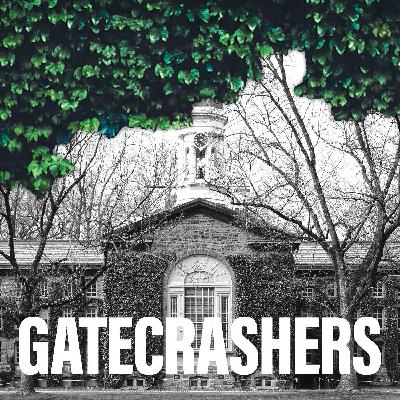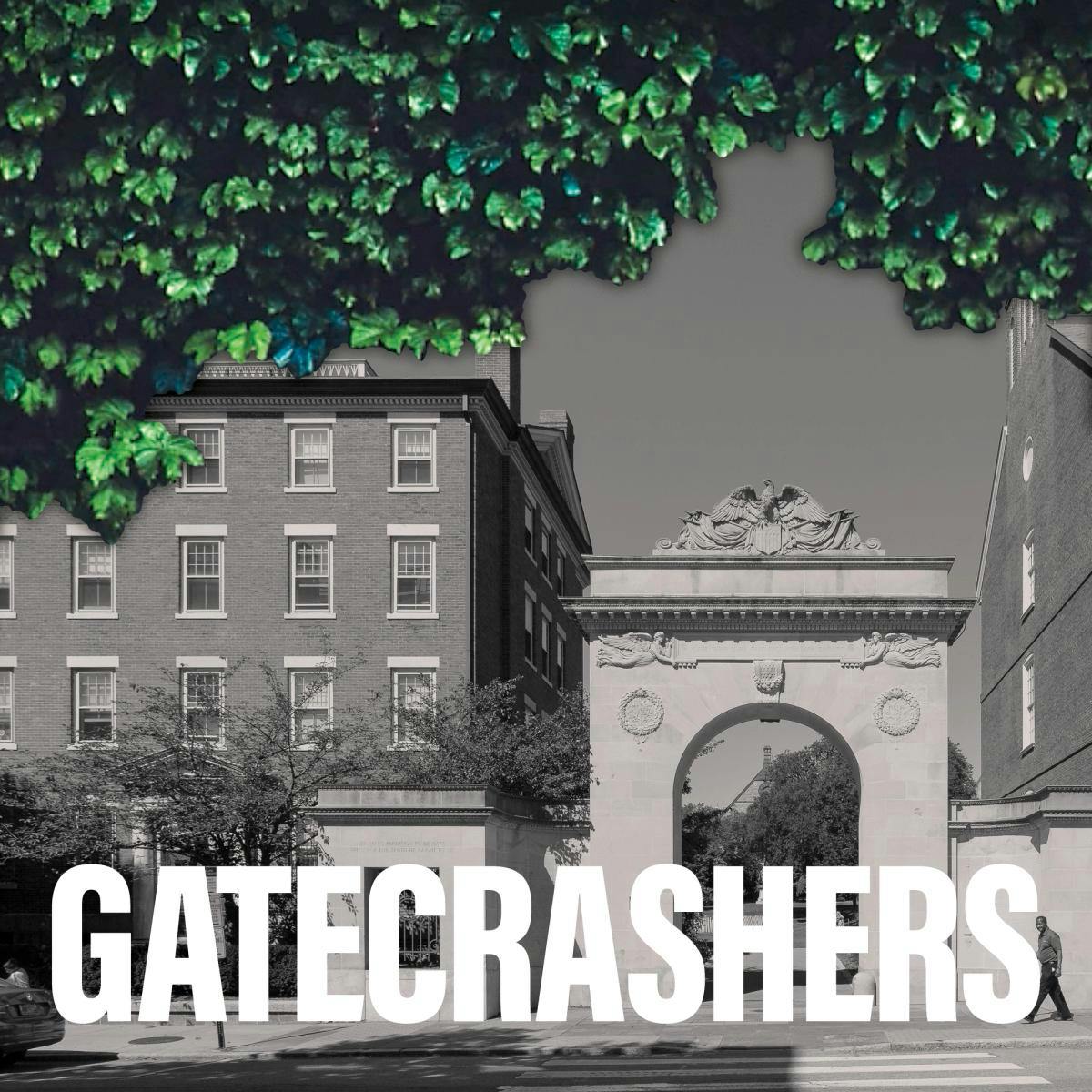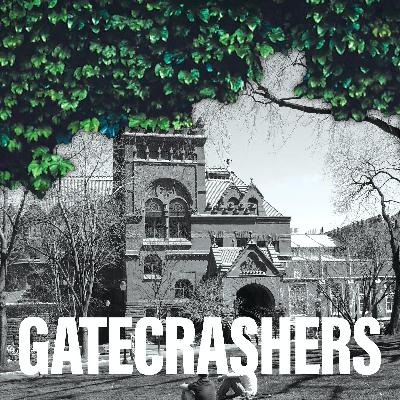Discover Gatecrashers
Gatecrashers

Gatecrashers
Author: Mark Oppenheimer
Subscribed: 12,975Played: 22,834Subscribe
Share
© 2023 Tablet Magazine
Description
From the team behind Unorthodox—the #1 Jewish podcast—comes a new eight-part series detailing the hidden history of Jews and the Ivy League.
Gatecrashers tells the story of how Jews fought for acceptance at elite schools, and how the Jewish experience in the Ivy League shaped American higher education, and shaped America at large. Hosted by Mark Oppenheimer, each episode focuses on one Ivy League school: Harvard, Yale, Princeton, Dartmouth, Columbia, Brown, Cornell, and the University of Pennsylvania.
11 Episodes
Reverse
What topic is more controversial, sensational, and endlessly captivating than college admissions? It’s a billion-dollar industry. It sends celebrities to jail. The Supreme Court is weighing in on who gets in and why. We might think we have read all there is to read on the issue, and heard all there is to hear. But if you want to understand everything that’s going on with college admissions today—not just the battles over diversity, but the very existence of college applications, the essays and interviews and standardized tests—you have to look at the first group that tried to diversify elite schools. You have to look at the Jews. Gatecrashers, an 8-part podcast series launching Sept. 13, 2022, tells the story of how Jews fought for acceptance at elite schools, and how the Jewish experience in the Ivy League shaped American higher education, and shaped America at large.
Isaac Asimov was one of the most prolific authors in history. He was best known as a pathbreaking sci-fi writer, but his more than 500 books also included volumes on the Greeks, the Romans, Shakespeare, the Bible, and much more. He was one of the most learned men in history.
But in 1935, 15-year-old Asimov was rejected by Columbia University. Admissions officials instead directed him to Seth Low Junior College, a separate campus in Brooklyn, 11 miles from Columbia’s Morningside Heights campus.
What was Seth Low Junior College, and why was the brilliant Isaac Asimov sent there instead? Seth Low Junior College, which existed from 1928 to 1938, was one of Columbia’s many attempts to deal with a changing student population that they felt was contaminating its pristine, Protestant campus. And it’s part of the bigger story of how the Ivy League resistance to outsiders shaped all of higher education as we know it.
In the first episode of Gatecrashers, a new podcast from Tablet Studios, you’ll hear about the lengths Columbia went to in order to limit the number of Jewish students. The invention of the college application itself, the admissions interview, the push for geographical diversity, and more—all elements of the college admissions process as we know it today—trace back to Columbia’s effort to keep out the Jews. You’ll hear from NPR’s Robert Siegel, former Columbia College Dean Robert Pollack, historian Robert McCaughey, sci-fi scholar Alfred Guy, and Dr. Leeza Hirt, whose undergraduate reporting unearthed the history of Seth Low Junior College.
Back in the 1950s, the Princeton eating clubs were essential. The dining hall was only meant for freshmen and sophomores. The club you joined as a sophomore became not just a place to eat but the center of your Princeton social life, a place to hang out, nurture friendships, and make connections.
According to one estimate, by the late 1950s, the school was about one seventh Jewish. But the Jewish students were about to find out that just because you’re admitted doesn’t mean you’re accepted. In February 1958, at the end of the bicker process—like fraternity rush, but for eating clubs—there were 35 sophomores who got no bids at all. And most of them were Jewish. The scandal was immediately dubbed “the dirty bicker” by the national press; it was reported in the New York Times, the New York Post, Newsweek, and more. It nearly caused the downfall of the eating clubs.
In Episode 2 of Gatecrashers, you’ll hear about the dirty bicker from students who were there, and learn what it tells us about class, acceptance, and belonging. You’ll hear from best-selling author Michael Lewis, Steven C. Rockefeller, novelist Geoffrey Wolff, Abby Klionsky, who wrote her senior thesis about the development of Jewish life at Princeton, Joel Davidow, Paul Rochmis, Jerry Spivak, and more.
On the surface, all-male Dartmouth in the 1940s and 1950s seems like it would be deeply unappealing to Jews: rural New Hampshire campus, no Jewish girls within miles, a history of antisemitic fraternities. But Jewish alumni from that era seemed to love Dartmouth. Why?
Something about Dartmouth—maybe it was the bucolic campus, the mountains, all that fresh air—made for a more laid-back environment than at the other Ivies.
In Episode 3 of Gatecrashers, you’ll hear from Dartmouth alumni including journalist David Shribman, actor Stephen Macht, screenwriter Steven Geller, and Richard Press, Jewish scion of the preppy clothier J. Press, about how Jewish students embraced the great outdoors—and learned to love Dartmouth College.
It’s accepted as gospel—or at least reliable urban legend—that at nearly every Ivy League school in the mid-20th century, there were limits on the number of Jews admitted each year. The Jewish population, it was said, was capped at 10 percent of the student body. But was that true?
Episode 4 of Gatecrashers investigates the real story of Jewish quotas, examining the practice at Yale University. You’ll hear reflections from Sen. Joe Lieberman (Yale ‘64), Benjamin Zucker (Yale ‘58), and Tim Oppenheimer (Yale ‘67, and father of Gatecrashers host Mark Oppenheimer). You’ll also hear from former Yale admissions director Henry “Sam” Chauncey, who shares what he was told when he started his job in 1957, and Dan Oren, author of Joining the Club: A History of Jews at Yale.
How did Jewish quotas start at Yale, and how did they finally end? Listen and find out:
While today most American universities offer all sorts of dining accommodations, the on-campus dining scene in the 1950s was far less welcoming for students with specific dietary needs. For students who observed the Jewish dietary laws known as kashrut, and therefore didn’t mix milk with meat or eat pork or shellfish (among other restrictions), their options for elite colleges were narrowed even further, often to schools in big cities where kosher meat and other offerings could more easily be procured.
So when a kosher-keeping high school senior from New York City wanted to attend Brown in the late 1950s, he was directed to an observant Jewish home near campus in Providence, RI, where Miriam Smith cooked kosher meals for him and, soon, an increasing number of observant Brown and Pembroke students.
Episode 5 of Gatecrashers features reflections from Meryl Smith Raskin (Pembroke ‘66), Herschel Smith (Brown ‘62), Richard Hirsch (Brown ‘63), and others about Mrs. Smith’s kitchen and the fight to get the campus to provide—and subsidize—kosher meals. Scholars Rachel Gordan of the University of Florida and Zev Eleff of Gratz College offer a broader look at mid-century American Jewish life and the growth of America’s kosher food industry in the post-war period.
In the fall of 1970, a group of Jewish Cornell students did something radical. Energized by a Freedom Seder on campus led by Arthur Waskow and the countercultural movement sweeping a country, they created a Jewish communal house. The Cornell Havurah was an “an anti-establishment establishment,” completely independent with no deans, resident advisors, or national organizations overseeing it.
The havurah was a residential component of the Jewish counterculture, a larger movement that included Jewish feminism and a Jewish anti-war movement. Translating literally to “fellowship,” the havurah was outside the synagogue structure, a place where Jews would come together for prayer, classes, meals, hiking, folk-singing, and more.
At this time of great turmoil in the country, and in the Jewish world, Jewish students at Cornell responded by seeking shelter from the storm ... together. To live intentionally—and communally—as Jews was a brave and original act in 1970. It was a statement of ethnic and religious pride, made by a group of college students who wanted to live their Judaism every day. As the rotating cast of residents proved over the years to come, a Jewish house can be a space where Jews of all kinds, of all political persuasions and sexual orientations, and of every shade of religious observance, could find themselves and find joy with others.
Episode 6 of Gatecrashers features Arthur Waskow, and a host of residents and regulars of the various iterations of the Cornell Havurah including Carl Viniar, Naomi Guttman-Bass, Reena Sigman Friedman, Judy Feierstein, Howard Adelman, Naomi Levy, Susan Lehmann, Richard Lehmann, Shari Edelstein, Bruce Temkin, Joe Avni-Singer, Alan Edelman, and Erica Edelman.
By the late 1980s, most Ivy League schools were a fifth or a quarter Jewish—and the University of Pennsylvania was more Jewish than most. For starters, unlike several other Ivies, Penn was never a Christian divinity school. It’s located in the heart of a big city that has had a large Jewish population going back to colonial times. Plus, it offered a plethora of professional schools, which, as we’ve learned in this series, appealed to students seeking social mobility in the early and mid-20th century. In the 1980s, where this episode picks up, Penn was a place where Jews felt truly comfortable.
In this episode of Gatecrashers, we explore Jewish Greek life. Jewish sororities like Alpha Epsilon Pi and Sigma Delta Tau were founded in the early 20th century by Jewish women who were excluded from the Greek system and wanted to create their own sense of sisterhood and social structure. But in the late 1980s, that sense of solidarity seems to have faded. The national headquarters of Sigma Delta Tau stepped in to make some unusual adjustments to the Penn chapter, which had been facing a membership decline. They put the entire chapter on probation following a suspicious underage drinking charge, and brought in a social club called Alpha Zeta to fill the chapter’s ranks and leadership positions.
What does it mean to be a representative of Jewish womanhood, particularly in the 1980s, when stereotypes of Jewish women permeated American culture? What do the actions of SDT’s national leadership tell us about Jews’ place in the Ivy League, and in the wider culture, at that time? And when a minority reaches the point of feeling truly comfortable, is in-fighting inevitable?
Episode 7 of Gatecrashers features historian Shira Kohn on the rise and role of Jewish sororities, Judith Silverman Hodara on Penn’s Jewish history, and several SDT and Penn alumni on the events of 1987.
In the 1990s, Harvard’s student body was said to be nearly a quarter Jewish. According to the Harvard Crimson’s 2020 survey of the freshman class, 6.7 percent of respondents identified as Jewish. On the final episode of this series, we explore the declining numbers of Jewish students across the Ivy League, and try to understand why, at places like Harvard, there may be fewer Jewish students today than when discriminatory policies kept them out a century ago.
We also look at how the same playbook that was developed to keep Jews out of elite universities–from the application, to the interview, to legacy preferences, to the hunt for geographical diversity–is now being used against a different minority group: Asian Americans.
Episode 8 of Gatecrashers features Rabbi Jonah Steinberg, researcher and The Half Opened Door author Marcia Graham Synnott, Harvard Law School professor Jeannie Suk Gersen, and various former and current Harvard students.
Covering Their Tracks is the extraordinary story of a young man’s escape from a moving train bound for the Auschwitz concentration camp during the Holocaust, and his fight to hold the French national rail company, the SNCF, accountable for their actions as they later bid for lucrative high-speed rail contracts in the United States.
For more information visit http://tabletmag.com/coveringtheirtracks or search for Covering Their Track wherever you get your podcasts.
Dreyfus: A Very Modern Affair is an October 7th story, but one that begins not in 2023, but in October of 1894 with the arrest of French military officer Alfred Dreyfus, who also happened to be a Jew. The implications of his framing, arrest, incarceration and the fallout of his eventual exoneration reverberate today. Over this five-episode series, we examine how these events unfolded, and how they connect to the antisemitism that exists today.
Visit https://www.tabletmag.com/dreyfuspodcast or search for Tablet Studios on your podcast app for the rest of the series.
















hybin n8hmvbybbb77hi
7m